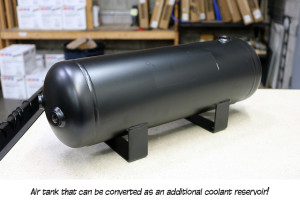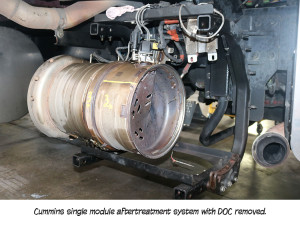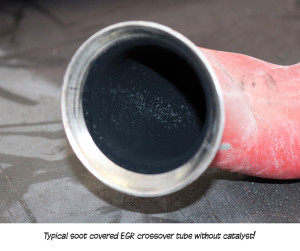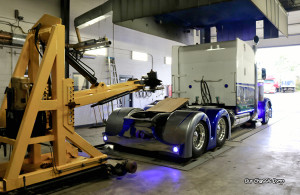 We have talked about auxiliary coolant tanks several times on our radio show. This is a cooling solution only to be used when a larger radiator is not available. I invented this system back in the early 1990s for the Big Cam 4 low flow cooling engines. We have used it several times on motor homes and other trucks with poorly engineered radiator systems. This is not a substitute for a poor radiator. When changing radiators, always call our shop with your radiator part number, and we will tell you if there is a high capacity radiator option for your truck. Installing an auxiliary cooling tank can cool your engine an additional 20 degrees, and it’s quite simple. Here’s how to do it.
We have talked about auxiliary coolant tanks several times on our radio show. This is a cooling solution only to be used when a larger radiator is not available. I invented this system back in the early 1990s for the Big Cam 4 low flow cooling engines. We have used it several times on motor homes and other trucks with poorly engineered radiator systems. This is not a substitute for a poor radiator. When changing radiators, always call our shop with your radiator part number, and we will tell you if there is a high capacity radiator option for your truck. Installing an auxiliary cooling tank can cool your engine an additional 20 degrees, and it’s quite simple. Here’s how to do it.
After purchasing a small air tank for a semi-truck (see photo), mount it in the frame rail near the transmission. Locate the pipe plugs in the coolant system of the block (usually the right side rear corner), drain the coolant, remove the pipe plug, and then install a shut off valve with a pipe nipple, preferably for use with one-inch hose. Run the hose along the frame rail to the front of the air tank and install another nipple in the tank. Remove the pipe plug on the rear of the air tank and install another nipple and attach the hose. Route the hose back to the engine and remove a pipe plug out of the thermostat housing, below the thermostat. Install another nipple and the hose from the tank. Add the standard amount of coolant back into the radiator plus another 5 to 6 gallons for the new coolant tank. That’s it! We have been solving truck engine problems for 43 years and will continue to do so.
 If you drive a used fleet truck, most likely your ECM software includes electronic babysitters. Electronic babysitters (sometimes called nannies) are a set of ECM software functions that limit the driver’s ability to control the driveline of the truck. The goal is to protect the drivetrain from user error. In practice, they deny the driver necessary power and RPM when needed, so the truck will pull slower and be less fuel efficient. Babysitters monitor MPH, RPM, and engine load, and if it thinks you don’t need the power, it will limit the available throttle, torque, RPM, and shift points (if you have an automatic). Imagine starting off with an extra heavy load at slow speeds with 150 less HP then the engine is rated. It’s extremely disappointing to drive a truck with these babysitters. Taking them off is the only way to unlock the truck’s full potential. The good news is that our Engineering Department can remove these babysitters for you. Most customers will combine this service with an ECM tune to unlock even more potential power. Almost every engine manufacturer has some sort of babysitting software. If you’re driving an old fleet truck, you’re missing out on some easy performance and mileage.
If you drive a used fleet truck, most likely your ECM software includes electronic babysitters. Electronic babysitters (sometimes called nannies) are a set of ECM software functions that limit the driver’s ability to control the driveline of the truck. The goal is to protect the drivetrain from user error. In practice, they deny the driver necessary power and RPM when needed, so the truck will pull slower and be less fuel efficient. Babysitters monitor MPH, RPM, and engine load, and if it thinks you don’t need the power, it will limit the available throttle, torque, RPM, and shift points (if you have an automatic). Imagine starting off with an extra heavy load at slow speeds with 150 less HP then the engine is rated. It’s extremely disappointing to drive a truck with these babysitters. Taking them off is the only way to unlock the truck’s full potential. The good news is that our Engineering Department can remove these babysitters for you. Most customers will combine this service with an ECM tune to unlock even more potential power. Almost every engine manufacturer has some sort of babysitting software. If you’re driving an old fleet truck, you’re missing out on some easy performance and mileage.
 Pittsburgh Power, along with our neighbors, Long Haul Custom Detailing, are having a truck show at our shop in Saxonburg, PA on Saturday October 3rd! We’ll have a show n’ shine, live dyno pulls, shop tours, five food trucks, and more. The dyno pulls will be on our chassis dyno (see photo). Discounted tunes will be available, as well. Please, no trucks over 1,000 HP, as we would like to preserve our dyno. Keep an eye on our website and social media channels for more details.
Pittsburgh Power, along with our neighbors, Long Haul Custom Detailing, are having a truck show at our shop in Saxonburg, PA on Saturday October 3rd! We’ll have a show n’ shine, live dyno pulls, shop tours, five food trucks, and more. The dyno pulls will be on our chassis dyno (see photo). Discounted tunes will be available, as well. Please, no trucks over 1,000 HP, as we would like to preserve our dyno. Keep an eye on our website and social media channels for more details.
Several of my friends that run or manage new truck dealerships tell me 75% to 80% of their shop work is emissions related. The trucks are under warranty, and the dealerships have very high labor rates (as high as $204/hour), so to protect that work, they will not sell our Max Mileage fuel borne catalyst (FBC) because it eliminates most of these problems. The same thing happened at our shop – once all our clients put their trucks on the catalyst diet, we almost had an empty shop. It took about two weeks for the shop to fill back up with other trucks and work. Now, we rarely see a truck with emissions related problems at Pittsburgh Power. However, there is still plenty to be accomplished. So, the next time you’re at a truck dealership, ask them why they do not sell our product, and then let me know what they say.
I want to share a customer review I recently received about our Max Mileage FBC product. Soot is the downfall of most new diesel engines, but with Max Mileage, it’s just not a problem anymore.
 “I recently had my Cummins dealer set valves and injectors and check over some of our X15 engines that will be running out of warranty soon (we have not been purchasing extended warranties, so we only have the 2 year/250,000 miles of coverage). I told the tech I wanted him to tell me if he sees anything different on these trucks, because I’m running a catalyst in the fuel that burns up more of the soot. He replied that if it’s working, he will be able to tell as soon as he pulls the EGR crossover pipe. After several hours, I went to see, and he asked what our secret additive is. I said no problem, but I wanted to know what he saw. He proceeded to tell me that there was virtually no buildup in the EGR crossover pipe (normally he’d see 1/8th-inch of buildup), and that he could still see the wall of the pipe. He also said the oil was very clean. Normally, a dab of residual oil from under the valve cover on the ISX feels gritty when rubbed between the fingers. Our trucks had none of that, and they are going 105 hours between regens. We both know the product works, but it’s great to hear a Cummins technician tell you that whatever you’re doing, keep it up. The tech also said that he had never seen anything like this before and sent pictures to his boss. Thanks for a great product. Don Shantz of Vernla Livestock Inc. in Wallenstine, Ontario, Canada.”
“I recently had my Cummins dealer set valves and injectors and check over some of our X15 engines that will be running out of warranty soon (we have not been purchasing extended warranties, so we only have the 2 year/250,000 miles of coverage). I told the tech I wanted him to tell me if he sees anything different on these trucks, because I’m running a catalyst in the fuel that burns up more of the soot. He replied that if it’s working, he will be able to tell as soon as he pulls the EGR crossover pipe. After several hours, I went to see, and he asked what our secret additive is. I said no problem, but I wanted to know what he saw. He proceeded to tell me that there was virtually no buildup in the EGR crossover pipe (normally he’d see 1/8th-inch of buildup), and that he could still see the wall of the pipe. He also said the oil was very clean. Normally, a dab of residual oil from under the valve cover on the ISX feels gritty when rubbed between the fingers. Our trucks had none of that, and they are going 105 hours between regens. We both know the product works, but it’s great to hear a Cummins technician tell you that whatever you’re doing, keep it up. The tech also said that he had never seen anything like this before and sent pictures to his boss. Thanks for a great product. Don Shantz of Vernla Livestock Inc. in Wallenstine, Ontario, Canada.”
Well, there you have it. Another satisfied customer who believes in our product. If you don’t believe in it yet, you just haven’t tried it yet! If you would like to, give us a call at (724) 360-4080, visit our website (www.pittsburghpower.com), or stop by our shop in Saxonburg, PA. We’d love to make you a believer, too.
